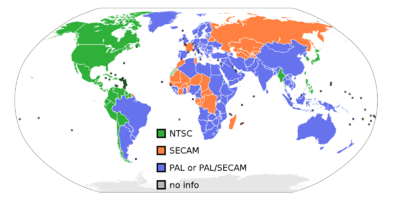PAL: Difference between revisions
No edit summary |
(total rewrite) |
||
| Line 1: | Line 1: | ||
{{ArticleIcons| | {{ArticleIcons|series=y}} | ||
[[File:PAL-NTSC-SECAM.png|thumb|400px|Regions of the world which used the different encoding systems]] | [[File:PAL-NTSC-SECAM.png|thumb|400px|Regions of the world which used the different encoding systems]] | ||
{{art-wikipedia}} | |||
Within the video game community, '''PAL''' is a term used to refer to the region of Europe, Asia (minus Japan), Africa, and Australia. The term comes from the analog television encoding system '''Phase Alternate Line''', the primary method of encoding analog TV for these parts of the world. | |||
PAL is most commonly used as shorthand for "the European version of a game". Historically, Europe is usually the third and final region for games made in Japan to be released, as games have to be translated into several languages, a process that takes both more time and more space than the [[NTSC]] region. In addition, due to cultural differences, the English translation cannot always be simply copied from the American version of the game. As a result, PAL releases are often the final version of the game, with all known bugs fixed and possibly significant changes added. | |||
==Summary of PAL releases of the ''Super Smash Bros.'' series== | |||
===''Super Smash Bros.''=== | |||
The original ''[[Super Smash Bros.]]''{{'}}s PAL release is not notably different than its NTSC version, retaining all its changes while not adding additional non-aesthetic ones. | |||
===''Super Smash Bros. Melee''=== | |||
The PAL version of ''[[Melee]]'' began with the 1.2 version from NTSC, but then added balancing changes to several characters, resulting in dramatic metagame differences between the two regions. For example, {{SSBM|Falco}}'s down aerial can no longer [[spike]] opponents during the late hit, and so is harder to use effectively. {{SSBM|Fox}}, {{SSBM|Sheik}}, and {{SSBM|Marth}} have also been [[nerf]]ed in notable ways. | |||
It should be noted that many of the PAL version's attributes - such as Falco's down aerial and the [[semi-spike]] being removed from the entirely of {{SSBM|Link}}'s [[Spin Attack]] - remain unchanged in ''Brawl''. As a result, it appears that the developers used the PAL version of the game as the base when developing ''Brawl'', as opposed to any of the NTSC or Japanese versions, implying they consider the PAL version to be the definitive version of the game. | |||
===''Super Smash Bros. Brawl''=== | |||
In order for cross-region online play to be possible, the only differences between versions of ''[[Brawl]]'' are purely aesthetic. | |||
== See also == | == See also == | ||
* [[NTSC]] | * [[NTSC]] | ||
* [[ | * [[List of regional version differences]] | ||
[[Category:Game regions]] | [[Category:Game regions]] | ||
Revision as of 19:22, June 4, 2014
Within the video game community, PAL is a term used to refer to the region of Europe, Asia (minus Japan), Africa, and Australia. The term comes from the analog television encoding system Phase Alternate Line, the primary method of encoding analog TV for these parts of the world.
PAL is most commonly used as shorthand for "the European version of a game". Historically, Europe is usually the third and final region for games made in Japan to be released, as games have to be translated into several languages, a process that takes both more time and more space than the NTSC region. In addition, due to cultural differences, the English translation cannot always be simply copied from the American version of the game. As a result, PAL releases are often the final version of the game, with all known bugs fixed and possibly significant changes added.
Summary of PAL releases of the Super Smash Bros. series
Super Smash Bros.
The original Super Smash Bros.'s PAL release is not notably different than its NTSC version, retaining all its changes while not adding additional non-aesthetic ones.
Super Smash Bros. Melee
The PAL version of Melee began with the 1.2 version from NTSC, but then added balancing changes to several characters, resulting in dramatic metagame differences between the two regions. For example, Falco's down aerial can no longer spike opponents during the late hit, and so is harder to use effectively. Fox, Sheik, and Marth have also been nerfed in notable ways.
It should be noted that many of the PAL version's attributes - such as Falco's down aerial and the semi-spike being removed from the entirely of Link's Spin Attack - remain unchanged in Brawl. As a result, it appears that the developers used the PAL version of the game as the base when developing Brawl, as opposed to any of the NTSC or Japanese versions, implying they consider the PAL version to be the definitive version of the game.
Super Smash Bros. Brawl
In order for cross-region online play to be possible, the only differences between versions of Brawl are purely aesthetic.

